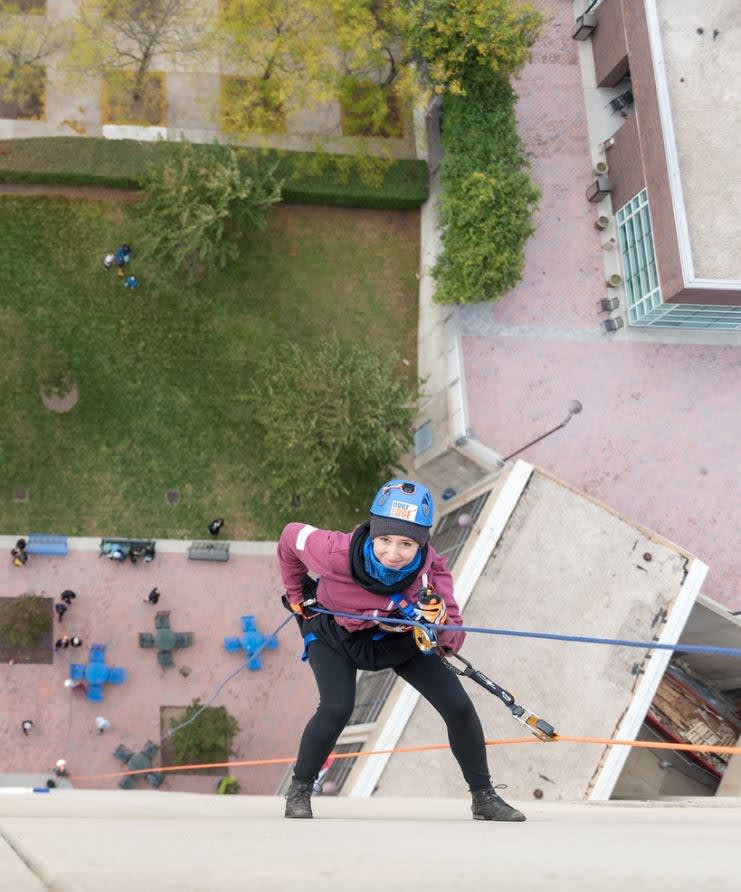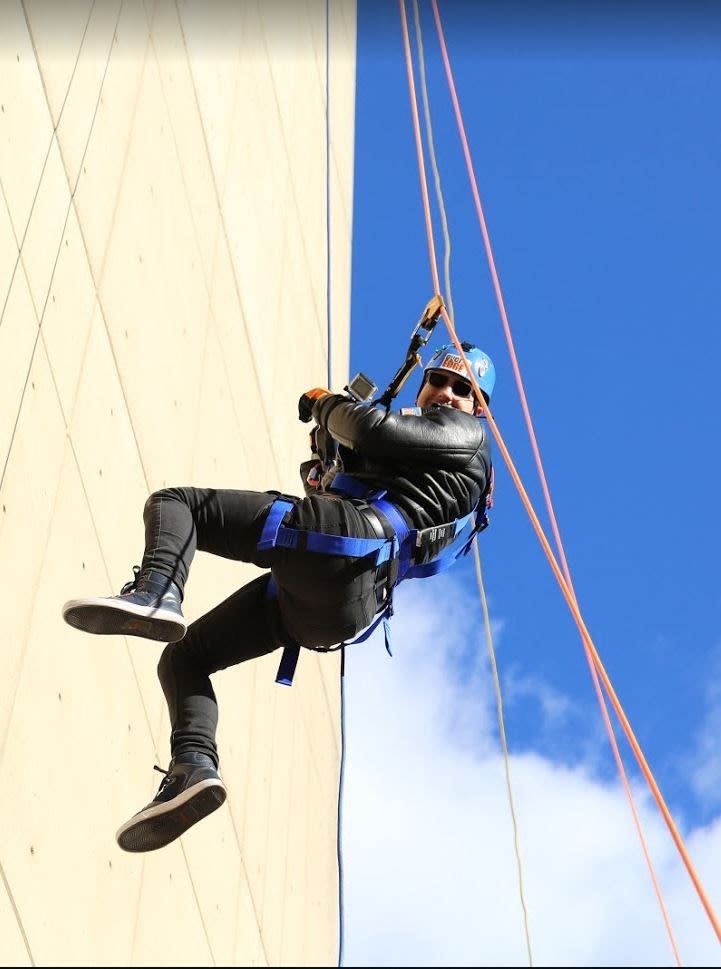1. Arrive at the Event. Meet OTE techs and DMCF reps.
2. Head to staging to pick up your rappelling gear (helmet, radio, participant waiver, full body industrial harness). Remember to empty your pockets and secure all drop hazards.
3. Training Rappel: Get comfortable in the harness with a quick training.
4. Navigate to the edge and descend. You’ve got this! Will you look down?
5. Touch down at the landing zone. Some high fives are in order!
6. That’s a wrap! Head back to staging to remove gear and retrieve personal items. Don’t forget to SHARE!
PARTICIPANT EVENT DAY PREPARATION
Here are some things you might like to know…
IN GENERAL
- This is not your typical rock climbing rappel! You will be wearing a full-body industrial harness and using an industrial descender to go down. To a certain extent, you can control your speed. Should you go too fast, the back-up device will engage, and you will stop.
- Getting your weight off the roof and into the harness is the most difficult part of the rappel for most people. You will have an opportunity to practice your technique during training, and an OTE Technician will guide you through these first few steps. Once you’re over the edge, you will have a radio to communicate with your OTE Technician.
- It will take between 5 to 15 minutes to get to the bottom. Rappelling can take more effort than some people expect, and you may find that your hands or arms get tired. You can stop to rest or switch hands if you need a break.
- If you keep your feet on the concrete/glass, it is easy to maintain the correct position. You won’t spin around or drift into the building. On some buildings you will not be able to touch the building. You can maintain the correct position by sitting up in your harness as if you were sitting in a swing. An Over The Edge staff member at the bottom of the rope will help keep you from spinning. Once you’re within 20’ of the ground, your landing will be assisted by the Over The Edge staff.
TRAINING
- Training begins in the Staging Area, where participants get into their gear and are provided the equipment they will need to rappel. We adjust harnesses and other equipment to fit each individual, and teach the participants about the correct way to wear their gear.
- In the Training Area, we train participants how to use the descender and back-up device, which are the two pieces of equipment they will need to use during their rappell. The descender we use is a ‘Petzl I’D’. We use a ‘Petzl ASAP’ as our back up device. We discuss how to properly operate the I’D as well as what causes the back-up device to engage and how to correctly release the ASAP.
- After demonstration by an OTE technician, each participant has the opportunity to simulate the actual rappell before going “Over The Edge.”
THE MAIN RAPPEL
- Training takes approximately 20-30 minutes, and once training is complete, participants head over to the main rappel.
- Our OTE Technician will get each participant attached to the ropes, and their gear and equipment will get a final check to ensure that everything is correctly positioned prior to committing to the mainline. Once the final safety check is complete, the OTE Technician will assist each participant “Over The Edge.”
- There are eyes on our participants at all times, from the OTE Technicians assisting at the top and monitoring the rappel, to our ropes volunteers below, who provide a fireman’s belay during the rappel to assist people with getting off rope at the bottom.
- If a rappeller is unable to complete the rappel on their own, due to fright, fatigue, etc., we can lower the ropes from the top. This also allows us to facilitate rappels for people who may not have the strength or ability to work the descent device.
- Unlike recreational rappelling, if you release your hands during your rappel, you will simply stop! Feel free to do this during your rappel, and take some time to enjoy the view.
WHAT TO WEAR
- You’re going to be walking down the side of a building, so wear good shoes. Well-fitting sneakers, light hiking boots, or other soft soled shoes are recommended. No sandals, slip-on shoes, slippers, flip flops, high heels, or steel toed boots will be allowed.
- Comfortable long pants (tights, athletics pants) or shorts are recommended. Long or short sleeve t-shirts are best. The harness goes around your legs, waist, and shoulders, so it is best to avoid anything too bulky. Shirts should be comfortable and without draw cords. Hair should be tied back. For women who would like to wear a skirt, please wear leggings or athletic pants underneath so that the harness can properly fit. Please note there will be a private staging area for women to put on their harnesses.
- You will be required to leave droppable items like keys and cell phones, or jewelry that can get caught on things, with a staff member on-site. You will be given a pair of leather gloves and a helmet when you arrive.
CAMERAS AND PHONES
- Sorry – no phones, cameras, etc. on the roof. Helmet cams that operate hands-free are permitted if you have one and want to bring it. You must supply the mounting system. Go-Pro cameras are approved; all others will require preapproval. For safety reasons, nothing goes over the edge without OTE’s approval.
SPECTATORS AND FRIENDS
- We encourage you to invite your friends and family to come cheer you on as you rappell! At the base of the tower, there will be food, music, and activities for all!
WHAT CAN I DO TO PRACTICE?
- No experience is necessary and you will receive all the training you need on the day of Over the Edge. However, if you would like, you can go rock climbing at a local climbing gym! Not only does rock climbing strengthen your forearms, but also it allows you to hang in a harness. Although the harnesses we use are different, you will still get the idea of what muscles it takes to stay up-right.




